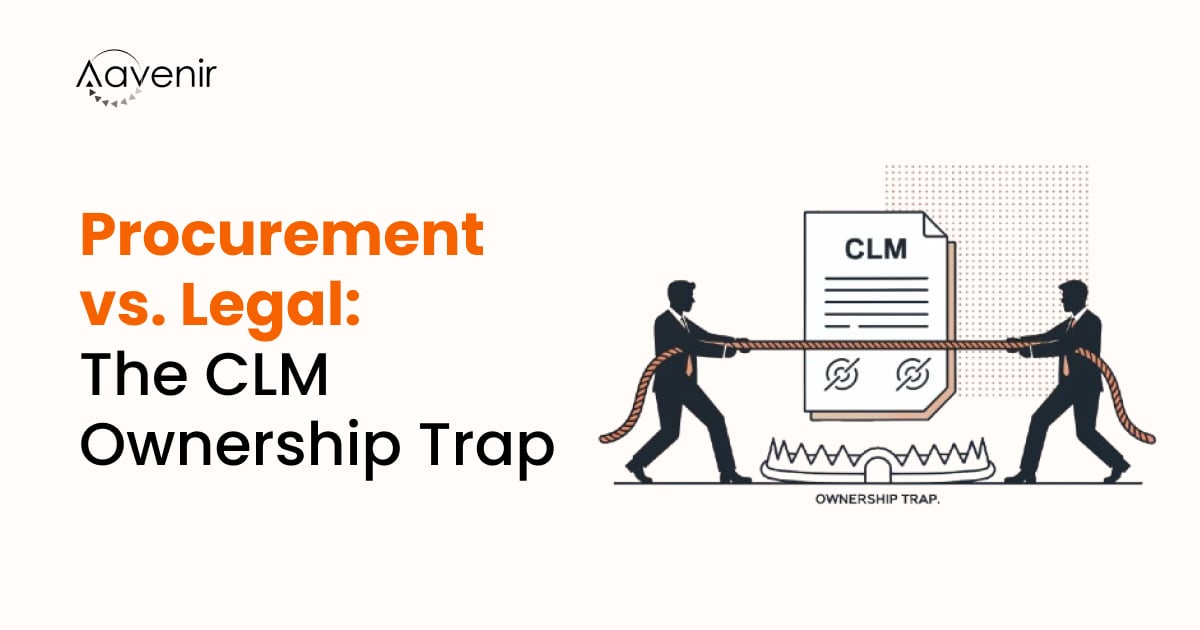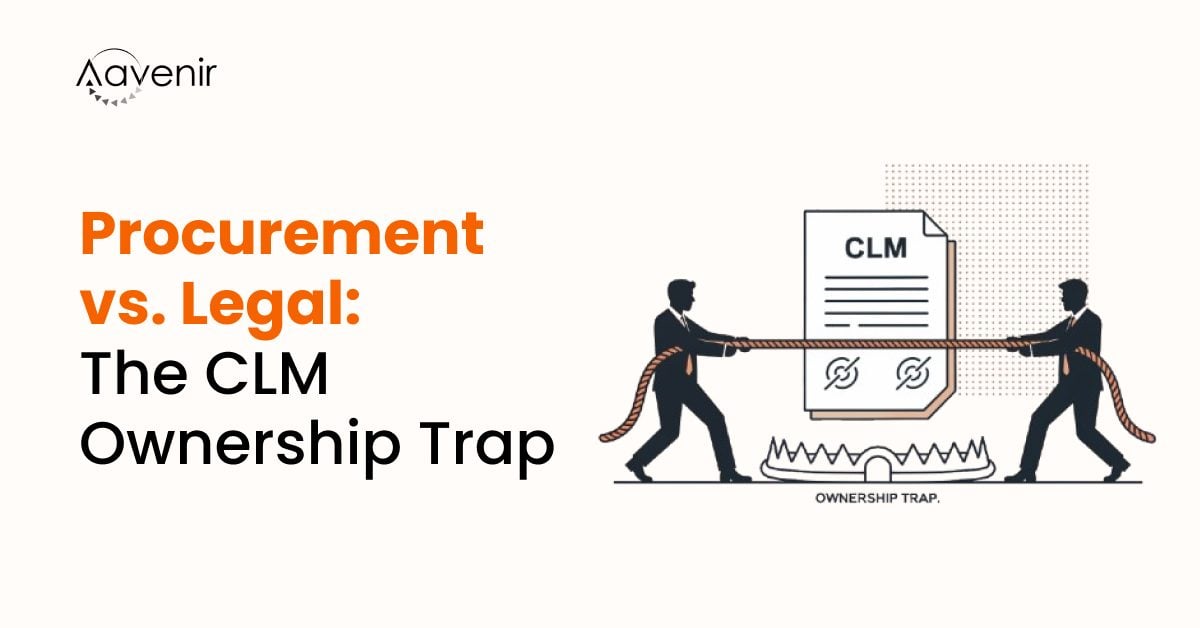Twenty years in enterprise contracts taught me one uncomfortable truth: when CLM “belongs” to only Procurement or only Legal, value hits a ceiling fast.
Procurement optimizes for speed and cost savings. Legal optimizes for risk and compliance. Both are right. Both are incomplete. And until you solve for shared ownership, your AI investments will underwhelm.
I’ve observed this pattern repeat across various industries: A manufacturer funds CLM through Procurement, achieves a smooth upstream flow, only to see deals stall in Legal review. Or Legal leads the implementation, tightens policy brilliantly, and the business starts routing around the system because it’s “too slow.”
The problem isn’t the tool. It’s unclear decision rights. And increasingly, it’s what stops AI from delivering on its promise.
The Story That Changed How We Think About This
A global manufacturer – seven regions, 12,000 suppliers – came to us after two brutal quarters. They’d invested in CLM through Procurement. Intake was clean. Onboarding was faster. Sourcing discipline improved.
But negotiations were a disaster.
Request-to-first-draft times ran 40% over target. Data Processing Agreements were triggered by “someone remembers we need one.” Legal was overwhelmed by SOWs containing 20+ indemnity variants due to unencoded clause fallbacks. Security reviews were consistently skipped due to time pressure.
The diagnosis wasn’t technical; it was organizational.
Decision rights were ambiguous. Risk triage happened via email archaeology. Approvals depended on institutional memory, not rules. When we shadowed five live deals end-to-end and audited their clause library, the root cause was clear: nobody owned the handoffs.
We didn’t switch tools. We switched the ownership model.
- Legal took policy: clause library with ranked fallbacks, approval matrix, regulatory posture
- Procurement took flow: intake design, playbooks, sourcing discipline, cycle-time SLAs
- IT took the platform: integrations, permissions, data governance, scalability
One quarter later: request-to-first-draft dropped ~30%. High-risk deviations fell materially on pilot templates. 100% of DPAs auto-routed. Internal audit cited “clear control points” for the first time in years.
The business stopped seeing CLM as a bottleneck. Legal stopped being the “contract police.” And Procurement’s savings claims finally had lineage to prove them.
Two Truths About Single-Owner CLM (And Why Both Fail)
When Procurement Leads Alone
What it optimizes: Orchestration and throughput – intake → sourcing → evaluation → award → onboarding → PO.
Typical wins: Standardized intake, competitive bidding discipline, faster supplier onboarding, visible cycle-time reduction, cleaner savings attribution.
Where it breaks:
- Negotiation guardrails wobble – clause deviations aren’t scored, fallbacks aren’t encoded, so every redline feels bespoke.
- Controls get skipped – DPA, InfoSec, and Privacy reviews are triggered by email lore instead of rules.
- Downstream obligations drift – renewals, SLAs, and audits lack clear owners; savings are claimed but not evidenced.
When Legal Leads Alone
What it optimizes: Governance and control – tighter reviews, smaller risk surface, playbooks that reflect regulatory reality.
Typical wins: Lower defect rates in signed contracts, better auditability, stronger obligations posture, clearer approval authority.
Where it breaks:
- Upstream chaos – request quality varies wildly because category and risk data aren’t structured.
- Cycle time balloons – business sees CLM as a bottleneck and starts routing around it
- Adoption stalls because sourcing discipline and vendor onboarding remain unchanged, meaning policy improvements don’t translate to outcomes.
The pattern is predictable: Single-owner CLM hits a local maximum. Throughput vs. risk becomes a culture war instead of an operating system.
Shared Ownership: The Only Model That Scales
The answer isn’t a compromise; it’s explicit decision rights that respect both mandates.
Here’s the handshake:
| Domain | Owner | Decides |
| Governance & Policy | Legal | Clause library, ranked fallbacks, approval matrix, regulatory posture – what “good” looks like |
| Orchestration & Delivery | Procurement | Procurement Intake design, sourcing playbooks, onboarding experience, cross-functional SLAs – how work flows |
| Platform & Data | IT / Business Systems | Integrations, identity, permissions, data model, availability –how it scales and sticks |
Shared responsibility: All three own adoption and outcomes. Disputes escalate to an executive triad (GC, CPO, CIO).
Critical handoffs to formalize (put these in writing):
- Risk triage at intake: Category + data sensitivity + spend + geography → rules auto-trigger DPA/InfoSec/Privacy
- First-draft SLA: Who drafts by contract type and risk tier; target times (median + p90)
- Deviation handling: AI scores map to approved fallbacks and route to the right approver by threshold
- Vendor readiness: Checklist ownership for banking/KYC/insurance – definition of “ready to transact”
- Obligations registry: Owner + due date + system of work for renewals, SLAs, audits, price protections
This isn’t bureaucracy. It’s the operating system that lets AI actually work.
Why AI Makes This Tension Sharper (And More Solvable)
Most “AI for CLM” still amounts to better search. Useful, but insufficient.
Reasoning-grade CLM AI should:
✅ Cross-reference relationships across MSAs, SOWs, and addenda to surface compound risk (e.g., indemnity × data transfer × venue)
✅ Score & suggest – quantify deviation from your library and propose risk-aware, approved alternatives in the redline
✅ Trigger workflows – kick off DPA, security review, or due diligence automatically based on detected risk
✅ Preserve lineage – trace from intake → signature → obligation management so savings and risk reductions are provable, not anecdotal
When AI helps both sides win, adoption follows. Procurement gets throughput and automation. Legal gets context and control. The business no longer has to choose between speed and safety.
But here’s the catch: AI can’t reason over chaos. If your clause library has 47 indemnity variants with no ranked fallbacks, AI will amplify the ambiguity, not resolve it.
5 Decisions to Make Before You “Turn On AI”
- Clause Library Hygiene – Consolidate variants, define fallbacks, tag attributes (jurisdiction, data sensitivity, liability caps). AI can’t reason over chaos.
- Template & Playbook Map – Tie templates to use cases (buy-side, sell-side, services, software) and align stage-wise playbooks with if/then triggers the AI can act on.
- Intake Normalization – Standardize request forms so upstream data (category, risk flags, PII, spend) is structured – garbage in → garbage contracts.
- Approval Matrix & Delegations – Implement rules to enable AI to pre-route or auto-approve within established thresholds. The fastest redline is the one you never send.
- Obligation Tracking – Determine what to monitor (renewals, SLAs, audits, price protections) and where alerts should be directed (business owner, Procurement, Legal).
Metrics That Actually Move the Needle
Measure both flow and risk. Tie each metric to an owner and a decision.
Cycle Time (Procurement owner): Request → first draft → signature → first delivery. Track median + p90 so outliers don’t hide friction. Decision: where to add playbooks/auto-approvals.
Clause Deviation Rate (Legal owner): % of agreements with non-standard language weighted by risk. Instrument via AI deviation scoring mapped to your library. Decision: which fallbacks to tighten/allow.
Competitive Sourcing Adoption (Procurement owner): % of eligible spend through competitive bidding. Decision: enforce routing and coach requesters.
Supplier Onboarding Lead Time (Procurement/VRM owner): Request → vendor “ready” (bank/KYC/insurance complete). Decision: which checks to parallelize or pre-collect.
AI Assist Coverage & Uptake (Legal + Procurement): % of contracts where AI suggestions surfaced and were accepted/edited. Decision: where the AI is trusted vs. needs tuning.
Obligation Compliance (Business owner + Legal): On-time renewals, SLAs, and audits met. Decision: escalation paths and actual post-signature value.
Pick 3–5 to start. Publish monthly with trendlines. Add targets. Always slice by contract type, region, and deal size. Visibility → accountability → change.
A 90-Day Blueprint (No Boiling Oceans)
Days 0–30: Baseline & Guardrails
Inventory templates, clauses, and approvals kill duplicates. Stand up a Legal-Procurement-IT steering group. Define a pilot (one contract type, one region).
Days 31–60: Reasoning, Not Just Search
Pilot AI on one high-volume template (e.g., SaaS or services). Turn on deviation scoring + clause suggestions. Wire intake → sourcing → contracting → onboarding.
Days 61–90: Prove Value & Scale
Publish the first KPI dashboard. Celebrate fast wins (25–35% faster first draft). Add a second template. Introduce renewal/SLA triggers. Lock a quarterly shared roadmap.
Common Pitfalls (And How to Dodge Them)
❌ Tool first, policy later – If fallbacks are fuzzy, AI will amplify ambiguity. Fix policy before automation.
❌ Hero implementations – If success depends on one power user, it won’t scale. Design for the average Tuesday.
❌ Vanity AI – If insights don’t trigger work, outcomes won’t change. Tie detection to tasks.
❌ Siloed wins – Procurement savings without legal guardrails or legal control, without throughput, both hit a ceiling. Balance matters.
Where We’re Headed
The future of CLM isn’t a shinier search box. It’s systems that treat contracts as living business assets from sourcing through obligation management with AI that reasons across the lifecycle to collapse cycle time and risk together.
At Aavenir, that’s the lens we use to connect sourcing, onboarding, and contracting on ServiceNow, not as a feature checklist, but as a workflow decision system that respects both orchestration and governance.
Because Procurement and Legal are both right. Together.
For Your Next Leadership Meeting
Want a one-page executive brief with the KPIs and 90-day plan you can drop straight into your deck? Request the template here, and we’ll tailor it to your organization.
Or if you’re ready to see how shared ownership + reasoning-grade AI works in practice, book a working session and we’ll walk through your use cases.
Either way, the days of choosing between speed and safety are over. It’s time to build for both.



